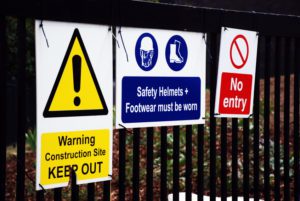The first International Standard for Occupational Health and Safety has quite rightly caused much excitement, but for many SMEs implementing any ISO Standard can be daunting, and a new health and safety standard particularly so.
Although ISO Standards are structured to enable them to be adapted to all sizes and types of organisations, we understand ISO 45001 might not be a short term goal.
Nevertheless, Occupational Health and Safety is important and employers have a statutory duty to protect their staff and other stakeholders who might be affected by their actions.
So here are 5 health and safety actions you can take now to reduce risks in your organisation:
Risk Assessment
Risk assessments have got a bad name over the years and can be seen as barriers to people working or having fun.
Actually, a risk assessment doesn’t necessarily need to stop you doing something. The purpose is to decide if the risk of harm is at an acceptable and manageable level.
You can often use controls and mitigating factors to reduce risks but more importantly, the risk assessment should consider the way you perform a task. There might be better ways to do something, or you might not need to do it at all.
The HSE provides easy to use templates for organisations and of course Assent Risk Management can help you understand the methodology and to document your risks appropriately.
Maintenance of Premises and Equipment
Poor maintenance of your premises and equipment can lead to accidents happening or the consequences of them happening being worse. Every site will have different requirements but here’s a list of common areas to focus on:
- Machine Guarding
- Lifting Equipment (LOLER)
- Floors and Surfaces
- Lighting, both natural and artificial
- First Aid Kits, Eye Wash and Fire Equipment
- Telephones and Communication Devices
Make a list of all the items you need to maintain and keep track of their maintenance. Even a visual check is better than nothing. Our partners Facility Assist can help with a Facility Audit.
Communication & Participation
No one knows the activities in your organisation better than the staff and that’s why it is essential to get them involved in identifying and managing health and safety risks.
Many SMEs see formal safety meetings as an unnecessary overhead, but there are many benefits to involving representatives from each area of your business in the planning and control of operations.
After all, safety should be embedded in business-as-usual operations, not an afterthought that sits on top.
So participation, followed by communication of the outcomes is important to creating a safety culture. There are many ways to communication outcomes of meetings and new policies you are implementing, including:
- Old Fashioned Noticeboards.
- Emails and Newsletters.
- Signage.
- Digital Screens.
Supplier and Customer Engagement
There are many other interested parties who may impact your operations including suppliers, customers, landlords, neighbours and so on.
Engaging with these parties to discuss common issues will also help you manage associated risks.
Communicating your expectations and finding mutually beneficial solutions to problems spreads the burden and the cost.
Keep up to date
UK Health & Safety Legislation is some of the largest that organisations have to deal with, and it’s regularly changing as technology develops.
In addition to legal requirements the HSE and other industry bodies publish and regularly revise guidance on a variety of subjects.
It’s important to keep up-to-date. Join or Subscribe to organisation who promote this information such as:
- The HSE
- Industry and Trade Bodies
- Assent’s Daily, Weekly and Monthly Newsletters.
And When You’ve done all that…..
Not only will you have reduce the risk of harm and be able to demonstrate your legal duty of care to employees, but you will also be 5 steps closer to achieving ISO 45001, or other safety qualifications, which should be carefully considered.
ISO 45001 Certification and other schemes, provide an independent assessment of your arrangements, drive improvement that you may not have considered and can help when tendering for work.
Contact us for a pragmatic approach to Health & Safety, and Certification.


